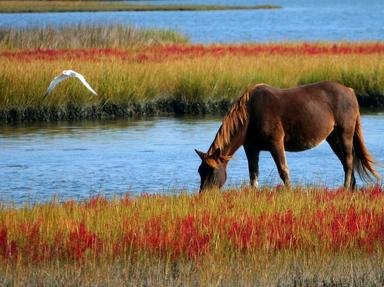Quiz Answer Key and Fun Facts
1. Known for their hardiness, strength and sure-footedness, this is one of the best-known mountain and moorland breeds of pony in Great Britain. Can you recognize this breed seen her in this rather unusual photograph?
2. These sturdy and muscular ponies developed from animals brought to the New World by settlers coming from Britain in the 17th and 18th centuries. Today there are estimated to be around 300 widely-dispersed animals. Which type of pony is this?
3. Extreme weather conditions have made this breed naturally hardy with excellent stamina. Over the centuries they have been put to work in local quarries and tin mines, but they roam today in semi-feral state. Which is pictured here?
4. Well adapted to the harsh mountain region where it traditionally lives, this endangered, semi-feral breed of pony is native to the Pyrenees region of southern France and northern Spain. Which type of pony is this?
5. Ranging in height from 28 inches to a maximum of 11 hands (about 42 inches), this breed of pony is known for both its strength and its intelligence as well as its heavy coat. Originally used to pull carts in mines and on farms, today they are mostly ridden by children in horse shows and harness races. Which breed is this?
6. This ancient breed of pony originated in Galicia in northern Portugal. Generally used for riding or light farm work, they are also used as pack horses by the Portuguese military. Which breed of pony is this?
7. This draft pony breed originated in Ireland. Close to extinction in the late 20th century, it is now Ireland's 'Heritage Breed'. What type of pony is this?
8. A small breed of pony, standing between 11 and 12 hands high, the locals call it a horse but it is technically a pony because of its diminutive size. Hardy, friendly, adaptable and sure-footed, this breed comes in brown, chestnut and black. Found naturally only on one island group in the Atlantic Ocean, which breed is this?
9. An old but rare breed of pony native to Japan, they were used for transportation by fishermen during the early Edo period in the 17th century but left behind when the fishermen returned home. Which breed of pony is this?
10. Stocky and powerfully built, this breed is strong for its height and noted for both its hardiness and its endurance. Distinguishing characteristics are relatively large heads for their body size, small ears and a double-layered winter coat. Which breed of pony is this?
Source: Author
EnglishJedi
This quiz was reviewed by FunTrivia editor
Tizzabelle before going online.
Any errors found in FunTrivia content are routinely corrected through our feedback system.

